Solar
Erika and Achim Ginsberg-Klemmt
Solar
Jonathan Lwowski
Solar
Dr. Eric Schneller

Humax announced the launch of the Humax MX7 – its second-generation EV charger designed for domestic and business fleet markets. The Humax MX7 is a V2G-ready EV charger that enables users to benefit from vehicle-to-grid (V2G) functionality, along with multiple energy-saving and cost-optimizing features. Suitable for both home and commercial charging, the chargers will be available as socket-type and tethered models from June 2025.
V2G-ready Technology
The Humax MX7 series features an integrated Power Line Communication (PLC) module and ISO 15118 protocol, enabling seamless digital communication with EVs. This facilitates vehicle identification and future-ready V2G capabilities. The MX7 range has been engineered to support continuous software updates, enabling the addition of new smart features and ensuring long-term performance, flexibility and future compliance. All future Humax EV charger models will be equipped with an integrated PLC module with ISO 15118 as standard.
Intelligent and Cost-Efficient Charging
Humax MX7 chargers are compatible with most EV tariffs, helping users reduce electricity costs by charging during off-peak hours. Solar-compatible, they can also use surplus power from home solar systems for greener, more economical charging. Smart scheduling and adjustable charge levels provide complete control and customization.
Engineered for Safety
Safety is a top priority. The MX7 includes integrated temperature sensors, overcharge protection and a tamper-detection switch to ensure a secure and reliable charging experience.
Stylish and Customizable
The MX7 range has been designed to harmonize with modern home aesthetics. Users can personalize their chargers with a variety of interchangeable front facias. Installation is simple thanks to the charger’s hinged front panel, providing easy access during set-up.
Business Charging Made Simple
The MX7 supports Auto Charge via ISO 15118, eliminating the need for RFID cards or apps. The user can simply plug in and start charging. For businesses, vehicle recognition streamlines the tracking of company car charging at employees’ homes, making reimbursements easier. The system integrates with leading third-party platforms and apps for enhanced management and operational efficiency.
Jeff Kim, president of Humax, commented, “Following extensive research, we have developed the MX7 to provide both residential and business users with a combination of efficient EV charging, energy optimization and cost reduction in one solution. With the growing adoption of electric vehicles and smart grid integration, and the desire for individuals and businesses to prove a positive return on their EV investment, we designed this range to ensure ultimate home energy optimization as well as straightforward management of EV fleets – helping consumers and organizations to reduce operational costs and even generate energy revenues. With this launch, we continue our commitment to innovation and sustainability in the EV ecosystem, empowering users to optimize their energy consumption and costs while contributing to a greener future.”
Humax EV Charging | humaxcharging.com

Researchers at The University of Queensland have set a new world record efficiency for lead-free perovskite solar cells, advancing the development of safer, more sustainable solar technologies. A team led by Professor Lianzhou Wang, based at the Australian Institute for Bioengineering and Nanotechnology (AIBN) and the School of Chemical Engineering, achieved a breakthrough certified efficiency of 16.65 per cent using tin-based perovskite - a non-toxic alternative to the lead typically used in next-generation solar cells.
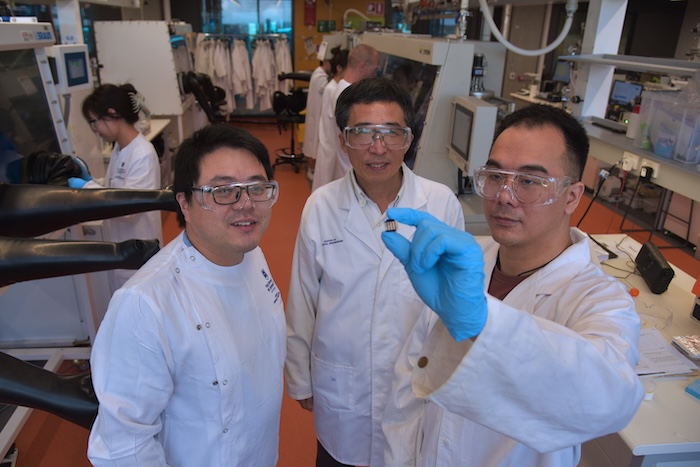
From Left to Right: Dr Peng Chen, Professor Lianzhou Wang & Dongxu He
“This is a major milestone for the field,” Professor Wang said. “To achieve such a high efficiency with tin perovskites, a non-toxic material, demonstrates the potential to deliver solar technologies that are both high-performing and safer for people and the planet.”
Researchers began exploring perovskite materials as a cheaper, more efficient alternative to traditional silicon-based solar cells, with lead-based versions offering some of the strongest early results, achieving impressive efficiencies over 25 per cent.
Their reliance on toxic lead has raised serious concerns around environmental safety and disposal, prompting efforts to search for more eco-friendly alternatives.
“Lead-based perovskites have long delivered high efficiencies, but lead is highly toxic and can potentially cause severe environmental pollution,” Professor Wang said. “Our results using tin shows that we can offer a safer path forward - without the need for lead and without significantly compromising performance.”
The tin-based solar cells build on the team’s previous world record using quantum dots, with the new eco-friendly material achieving energy efficiency one step closer to that of lead and silicon counterparts.
“Efficiency has always been the biggest hurdle with tin,” Professor Wang said. “Now we’re narrowing that gap and opening the door to a new generation of solar technologies that are not only safer, but also more versatile. “With further improvements, we could see flexible solar panels, indoor applications, and lightweight devices powered by our clean, lead-free energy – possibilities that aren’t fully achievable with lead-based materials.”
While the result represents a global benchmark, the team says further work is needed to optimise the technology for long-term use.
AIBN researcher Dr Peng Chen said the team’s breakthrough was made possible by carefully controlling how the tin material forms during fabrication.
“Tin is much less stable than lead as it reacts easily with oxygen and degrades, which reduces the cell’s performance and operational life,” Dr Chen said. “By using a colloidal chemical strategy with caesium, we were able to control how the material forms and make better-quality tin solar films that allowed us to achieve our more efficient and durable tin-based cells. “This record shows that we’re overcoming some of the key barriers of using tin, but further improvements in stability and efficiency will be key to unlocking its commercial use.”
The team – including AIBN researcher Dongxu He – will now focus on enhancing the durability of tin-based cells and refining production techniques to support scalable, real-world use including flexible panels and low-light-intensity indoor systems.
The research was supported by an ARC Laureate Fellowship, Discovery Project, and DECRA Fellowships, with additional contributions from the University of New South Wales and Australian National University.
AIBN | https://aibn.uq.edu.au/

In response to the Department of Interior’s (DOI) order halting construction activities on the fully federally permitted Empire Wind 1 project off the New York coast, Oceantic Network has released the following statement, attributed to Liz Burdock, president and CEO:
“Stopping work on the fully federally permitted Empire Wind 1 offshore project should send chills across all industries investing in and holding contracts with the United States Government. Preventing a permitted and financed energy project from moving forward sends a loud and clear message to all businesses - beyond those in the offshore wind industry - that their investment in the U.S. is not safe. We urge the Department of Interior to lift this order immediately to restore a predictable and equitable environment for the buildout of critical energy resources that help secure our energy future and independence."
Oceantic Network | https://oceantic.org/

DSD Renewables (DSD) has secured a master contract with School Project for Utility Rate Reduction (SPURR) to be its chosen developer partner for the Renewable Energy Aggregated Procurement (REAP) Program. Under this partnership, DSD will offer solar and energy storage solutions to California public school districts, county offices of education, community college districts and other public agencies based on SPURR’s competitively sourced pricing and contract terms.
The REAP Program helps eligible entities streamline their adoption of solar and energy storage systems through a proven cooperative procurement model. To date, the program has facilitated the contracting of 275 megawatts (MW) of solar capacity and 80 megawatt-hours (MWh) of energy storage for more than 75 public agencies across hundreds of sites in California.
SPURR selected DSD following an extensive request for proposal process that evaluated vendors based on pricing, system design capabilities, operational expertise, and an established track record of successful installations.
“We’re grateful for the opportunity from SPURR to deliver economical solar and storage solutions to schools, municipalities, and non-profits across California,” said Jacob Hoheim, Senior Director of Origination at DSD.
Participants in the REAP Program receive detailed project feasibility studies and savings analyses at no cost. These assessments help public agencies understand their potential energy savings and environmental impact before committing to solar, ensuring informed decision-making about their renewable energy investments.
Public agencies can benefit from SPURR’s streamlined REAP Program procurement process and DSD’s expertise in renewable energy design, development, and long-term operations and maintenance.
“Through our highly competitive RFP process, DSD emerged as the winning vendor for our REAP Program,” said Kevin Flanagan, REAP Program Manager at SPURR. “With its unique approach to project design and execution, and a history of successful projects, we’re confident DSD can help ensure this program continues to thrive and deliver valuable solar and storage solutions across California.”
SPURR is a California Joint Powers Authority of 340 member public school districts, community college districts, and county offices of education. Public agencies interested in learning more about the REAP Program can contact [email protected].
School Project for Utility Rate Reduction | https://spurr.org/
DSD Renewables | https://dsdrenewables.com/
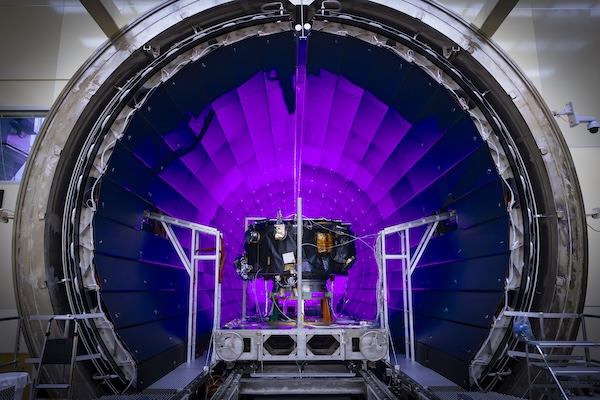
CB&I and a consortium including Shell International Exploration and Production, Inc. (Shell), a subsidiary of Shell plc, GenH2 and the University of Houston announced the completion of a first-of-its-kind, affordable, large-scale liquid hydrogen (LH2) storage tank concept at NASA's Marshall Space Flight Center (MSFC) in Huntsville, Alabama, that will enable international import and export applications.
"Our collaboration with this world-class project team will help provide a path to low-cost, large-scale liquid hydrogen storage," said Mark Butts, President & CEO of CB&I. "We are proud to leverage our six decades of experience with cryogenic insulation and storage to advance innovative solutions for the energy transition market."
The project, which began in 2021 and is supported by the US Department of Energy (DOE), developed a novel non-vacuum tank design concept for large-scale (up to 100,000 cubic meters) storage of LH2 that is anticipated to provide a substantial cost advantage over conventional vacuum-insulated tanks. This concept is being demonstrated through the construction, startup, and testing of a small-scale LH2 demonstration tank at NASA MSFC.
"At Shell, we believe in the power of collaboration to advance technology and scale up innovative solutions," said Theo Bodewes, General Manager, Hydrogen Technology. "With the invaluable support from the DOE, this project demonstrates how experts from industry, academia, and government can solve complex technology challenges. This novel liquid hydrogen technology promises to be more competitive, reducing costs and accelerating large-scale storage commercialization."
The demonstration tank will significantly increase the MSFC hydrogen test facility's LH2 storage capacity and be used to characterize the behavior of materials under cryogenic conditions, mimicking normal fill and empty cycles and testing non-vacuum insulation materials. In addition to an estimated six-month test period included in the project scope, a Space Act Agreement among the partner organizations provides for MSFC's use of the tank over a five-year period, during which CB&I and Shell will continue to test new insulation technologies under non-vacuum conditions.
"We take pride in participating in this industry collaboration to advance commercial liquid hydrogen storage applications," said James Fesmire, GenH2 Chief Architect. "This initiative has allowed us to develop testing capabilities for thermal insulation systems and produce essential data for unlocking the global potential of liquid hydrogen."
"This project is an example of a novel design brought to fruition by a partnership of academia, government agencies, and the energy companies," said Dr. Ramanan Krishnamoorti, Vice President of Energy and Innovation at the University of Houston. "The ability to store liquid hydrogen at scale using a non-vacuum design is a pivotal advancement and opens the door to a more flexible, affordable global hydrogen trade infrastructure. Innovative solutions such as this will be key to advancing our energy economy."
"This first-of-its-kind concept is a great example of unleashing American energy innovation – a key priority for the Department of Energy. Through collaborative expertise from industry, academic, and government agencies, this work can contribute to America's leadership in growing global markets for hydrogen and hydrogen-based fuels and offer greater opportunities for American energy operators to store, deploy, and export liquid hydrogen," said Dr. Sunita Satyapal, director of DOE's Hydrogen and Fuel Cell Technologies Office.
CB&I built the first LH2 sphere for NASA and NASA contractors in the 1960s, with a capacity of 170 cubic meters, and has expanded that threshold over the last sixty years by almost 30-fold to 5,000 cubic meters with a tank completed in 2022 at Kennedy Space Center for the Artemis program. CB&I has completed over 130 LH2 storage vessels since the 1960s.
The company and NASA have had a partnership of more than 60 years, with CB&I contributing to many NASA projects, including several supporting the Apollo and Gemini space missions.
CB&I | www.cbi.com
Shell plc | www.shell.com
NASA | https://www.nasa.gov/
GenH2 | www.genh2.com
University of Houston | https://uh.edu/

Mercom Capital Group, a global clean energy communications and consulting firm, released its report on funding and merger and acquisition (M&A) activity for the global solar sector in the first quarter of 2025.
Total corporate funding in the solar sector reached $4.8 billion across 39 deals in Q1 2025—a 41% decline year-over-year (YoY) compared to $8.2 billion raised through 42 deals in Q1 2024.
However, funding was up 20% quarter-over-quarter (QoQ) from the $4 billion raised in 40 deals in Q4 2024.
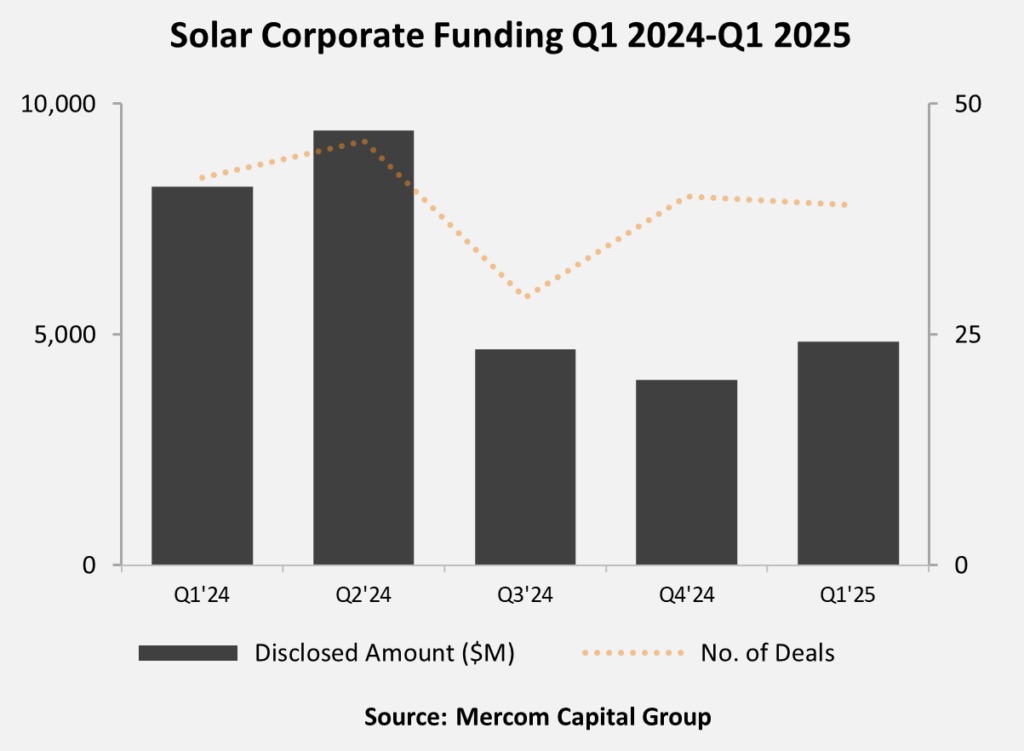
"The drop in funding this quarter reflects growing investor caution in response to policy reversals, tariff shocks, and regulatory uncertainties that have forced companies and investors to reassess their strategies. But the fundamentals remain strong, and the long-term case for solar is intact. What we need now is clarity and policy certainty to restore confidence in the markets. Despite headwinds in the broader funding environment, we did see an uptick in project M&A in Q1," said Raj Prabhu, CEO of Mercom Capital Group.
Global VC funding for the solar sector in Q1 2025 came to $1.4 billion in 14 deals, a 237% increase YoY compared to $406 million raised in 13 deals in Q1 2024. Funding increased 40% QoQ compared to the $1 billion raised in 21 deals in Q4 2024. The QoQ increase was primarily driven by a single $1 billion raise.
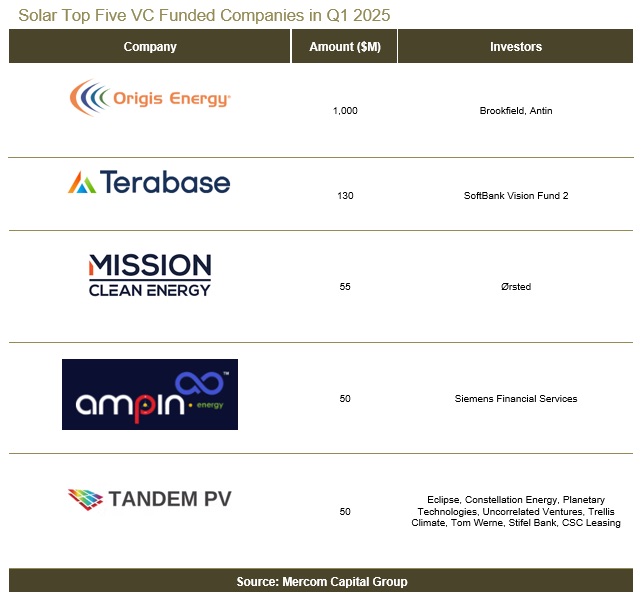
The top VC/PE-funded companies in Q1 2025 were: Origis Energy, which raised $1 billion; Terabase Energy with $130 million; Mission Clean Energy with $55 million; AMPIN Energy Transition with $50 million; and Tandem PV also with $50 million.
Of the $1.4 billion in VC funding raised in 14 deals during Q1 2025, 96% went to solar downstream companies, with $1.3 billion in 12 deals. In Q4 2024, solar downstream companies raised $661 million in 16 deals (65% of VC funding).
Public market financing in the solar sector totaled just $20 million across two deals in Q1 2025, a 99% decline YoY compared to $1.4 billion raised through six deals in Q1 2024. Quarter-over-quarter, funding fell 98% from $933 million raised in five deals in Q4 2024.
In Q1 2025, debt financing for the solar sector reached $3.5 billion across 23 deals, a 45% drop compared to the $6.4 billion secured in the same number of deals in Q1 2024. On a QoQ basis, debt funding rose 67% from $2.1 billion across 14 deals in Q4 2024.
A total of 19 solar corporate M&A transactions were recorded in Q1 2025, compared to 20 transactions in Q4 2024, and 10% lower compared to 21 solar M&A transactions in Q1 2024.
Solar downstream companies led corporate M&A activity with 16 transactions, one each for the balance of system, materials, and service provider companies.
Approximately 13.6 GW of solar projects changed hands in Q1 2025, up from 10.8 GW in Q1 2024. On a QoQ basis, project acquisition volume also increased, compared to 9.4 GW in Q4 2024.
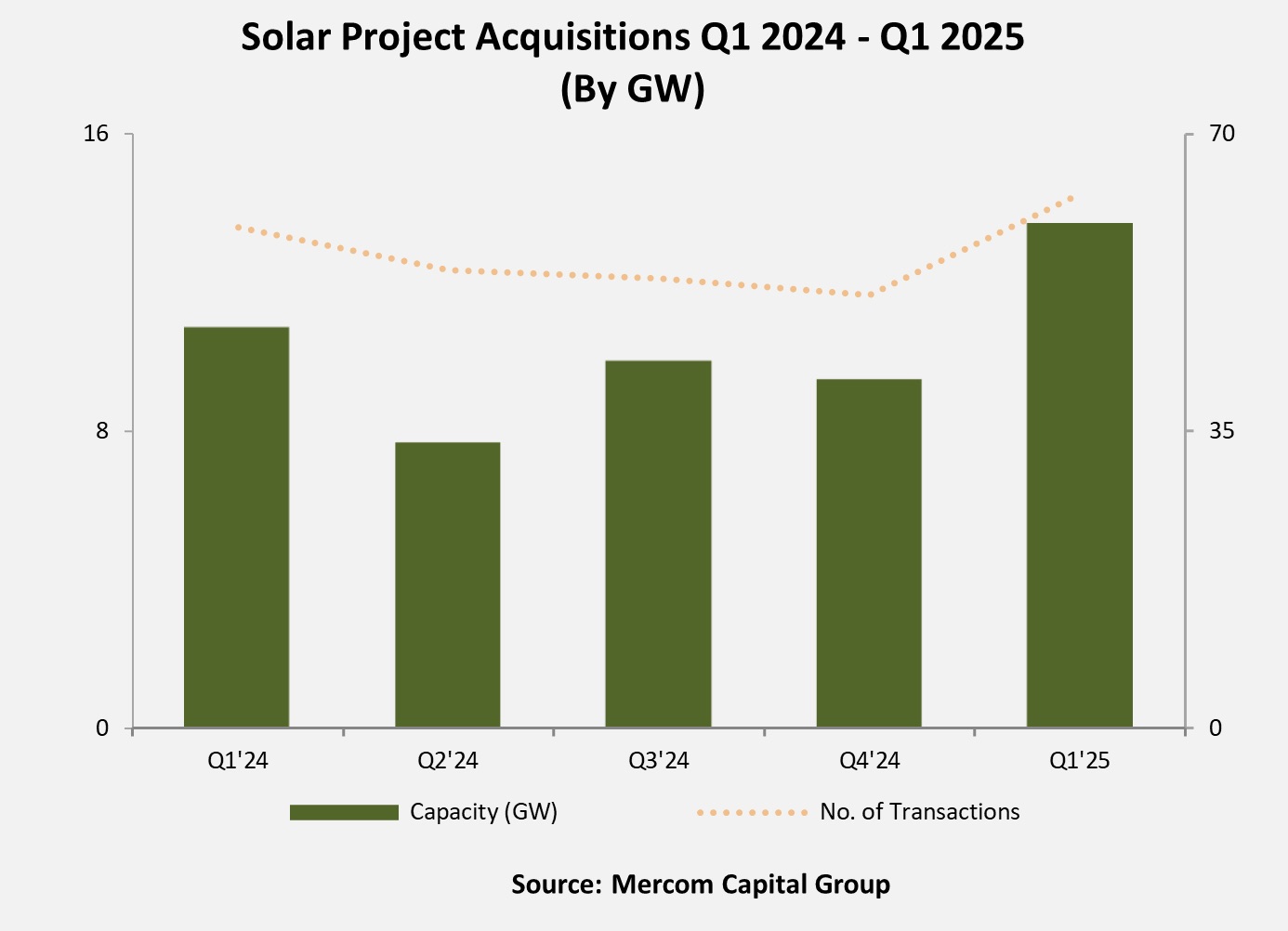
In Q1 2025, project developers and independent power producers led acquisition activity, securing over 8 GW of projects. They were followed by investment firms and funds, which acquired 2.5 GW. Telecommunications companies, integrated energy traders, insurance firms, and other undisclosed buyers picked up a combined 2.3 GW. Electric utilities acquired 485 MW, oil and gas majors took 245 MW, and installers accounted for the remaining 63 MW.
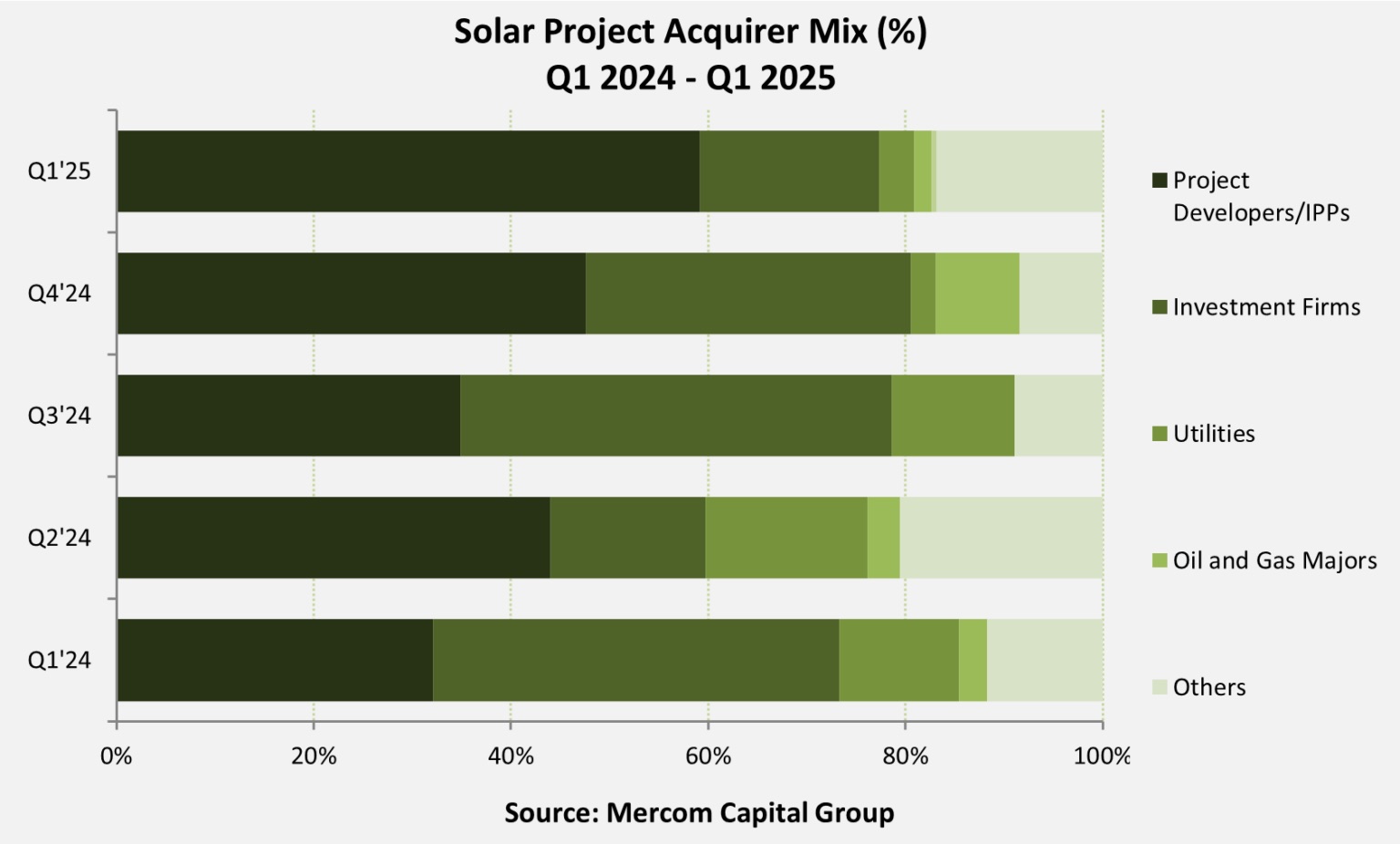
There were 263 companies and investors covered in this 91-page report, which contains 69 charts, graphs, and tables.
To learn more about Mercom’s Q1 2025 Solar Funding and M&A Report, visit:https://mercomcapital.com/product/q1-2025-solar-funding-ma-report/
Mercom Capital Group | http://www.mercomcapital.com

We're thrilled to welcome Arun Ramadass as our new VP of Operations at Castillo Engineering!
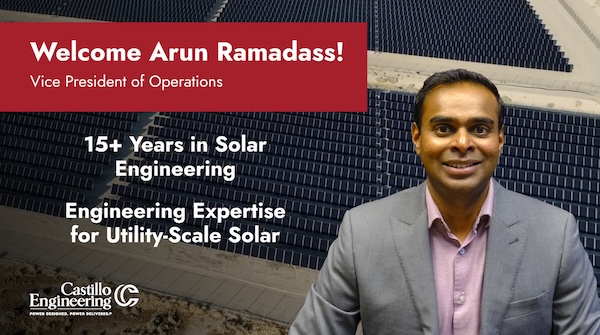
Arun brings over 15 years of diverse solar industry experience, including leadership roles where he focused on engineering utility-scale projects, strategic growth, and technical excellence. He has been instrumental in delivering innovative renewable energy solutions, guiding teams through complex challenges, and scaling processes for large-scale operations.
"I believe in empowering engineers with clear goals, the right tools, and a strong sense of purpose. My approach is collaborative—building a culture of accountability and continuous learning while staying laser-focused on execution," says Arun. "Success on large-scale projects depends on three key pillars: strong technical rigor, proactive communication, and a fully aligned team—from concept through to commissioning."
Arun’s passion for renewable energy comes from a drive to solve meaningful problems and create real-world impact. At Castillo Engineering, we share that vision—empowering utility-scale projects with customized, efficient, and cost-optimized engineering solutions that support every stage of the project lifecycle.
Welcome to the Castillo team, Arun! His expertise further strengthens our commitment to delivering projects of the highest quality with exceptional customer service.
Castillo Engineering | https://www.castillope.com/
Alternative Energies Mar 31, 2025
Green buildings are transforming the way we design, construct and operate structures by focusing on energy efficiency, environmental responsibility and occupant well-being. As technology evolves, innovations like organic printed semiconductor systems....
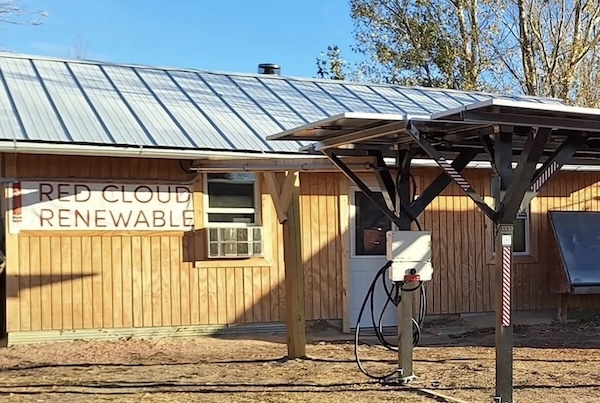
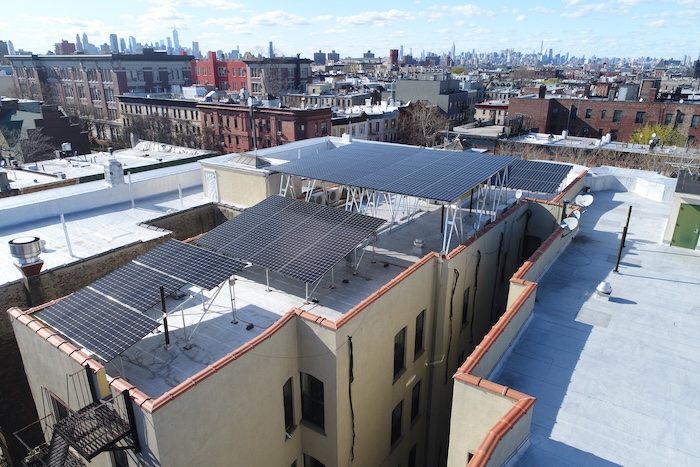
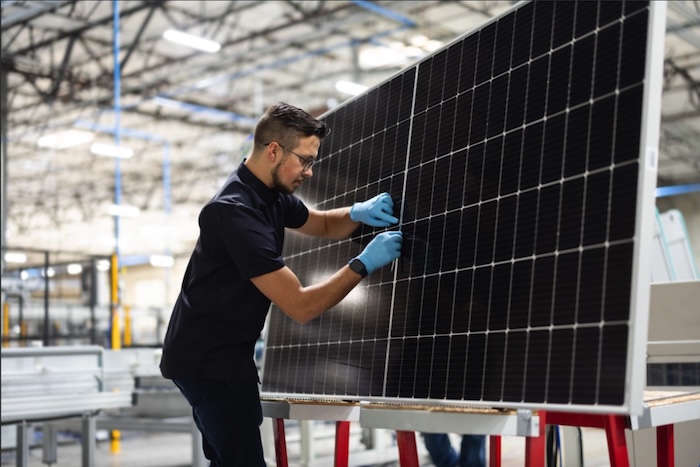
A historic milestone in renewable energy deployment has been reached in the United States, and it all started with the vision and leadership of Chief Henry Red Cloud at the Red Cloud Renewable Energy Center (RCR) in Pine Ridge, South Dakota....
Given the Trump administration’s past approach to renewable energy, solar developers and installers nationwide are bracing themselves for another period of lack of support for renewables. But the success of the Inflation Reduction Act’s (IRA) ....
The global solar industry has experienced substantial growth and maturation over the past decade. As a result, we now have easy access to high-efficiency solar panels equipped with extended warranties of 25 years or more. Considering that we rarely e....
Renewable energy sources such as wind an....
As wind energy continues to expand its r....
As the renewable energy sector continues....
Significant advancements in battery technology—including lithium-ion, solid-state, and other emerging technologies have occurred in recent years as was recently acknowledged by institutions such as the International Energy Agency and BloombergNEF([....
The move toward green, clean, sustainable energy will require a massive investment in research and development (R&D) to develop the innovations that will accelerate the modernization of North America’s electrical grids. Advancements in Battery ....
With the increase of electric vehicles on the road, there is growing demand for EV chargers. Drivers are left with a few different options: they can use a public charger, they can charge at work if they are lucky enough to have that option, or they c....
Green buildings are transforming the way we design, construct and operate structures by focusing on energy efficiency, environmental responsibility and occupant well-being. As technology evolves, innovations like organic printed semiconductor systems....
For fuel cell-powered transportation, the future hinges on investment in six key areas As a transportation mode that uses the universe’s most abundant element, one that’s renewable and yields zero tailpipe emissions other than water, hydrogen-....
As the global energy transition marches on, hydrogen remains a promising energy carrier for a decarbonized system. Demand for clean hydrogen is expected to increase two to four times by 2050, facilitating the shift to a carbon neutral grid and cleane....